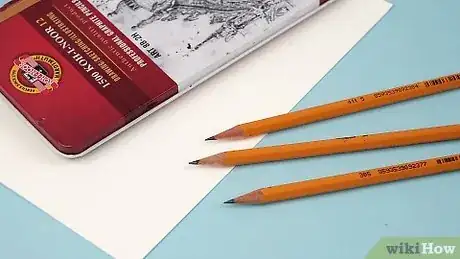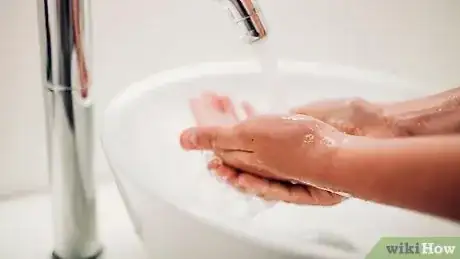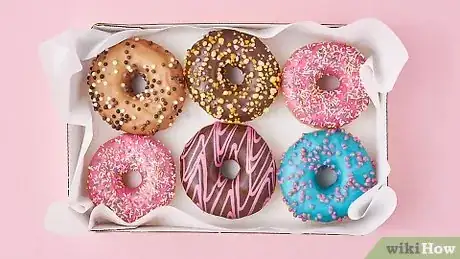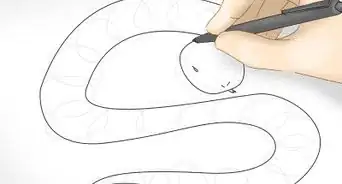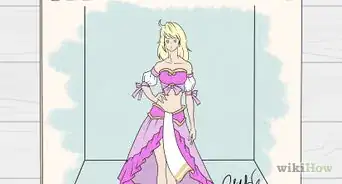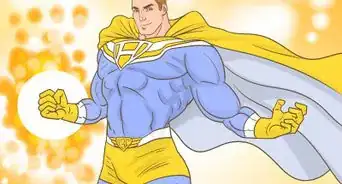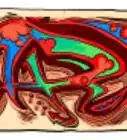This article was co-authored by Renée Plevy. Renée Plevy is an Internationally Acclaimed Portrait Artist from New York/Palm Beach who has painted The Grand Dames of Palm Beach and various celebrities and community leaders. With over 50 years of experience, Renée specializes in painting realistically in oil and capturing the soul of the person. She has studied under internationally renowned portrait artists John Howard Sanden, David Leffel, Robert Beverly Hale, Clyde Smith, and Leonid Gervits. Renée is featured in over 68 shows and galleries including a one-woman museum show at the Paterson Museum. She has garnered numerous awards including “Artist of the Year” from The Bloomfield Art League and First Prize from the Boca Raton Museum Artist’s Guild. Renée has even painted a portrait of celebrity, Vanilla Ice. She also teaches at the Boca Raton Museum Art School - formerly at SVA in Manhattan.
This article has been viewed 799,113 times.
The art of drawing a good picture involves practice and a willingness to keep trying. A good drawing requires a focus on technique and style. The more you learn about drawing techniques and the more you practice, the sooner you'll end up creating good pictures.
Steps
Preparing for Drawing
-
1Choose a good quality drawing pencil. A school pencil will give you a good medium shade line and a medium width of the line. If you want a darker pencil use a B pencil. Most craft and art stores sell drawing pencils. The best drawings use a variety of pencil shades.
- The higher the number, the darker you can go. For example, 6B is much darker than 2B.
- If you want a really light line use an H pencil. The higher the number the lighter the line. For example, 6H is much lighter than 2H.
-
2Keep the pencil point sharp. The sharper the point, the better you can draw. Sharpen it often as you draw.Advertisement
-
3Choose the perfect paper. The “tooth” of a paper is how rough and textured the surface is. Paper that is rougher, with a higher tooth, will collect more graphite for deeper shading, but the texture will show through and it may be difficult to add details and polish to your art. Paper that is very smooth, like Bristol board, will make for a cleaner looking finished product and an easier time adding small detail. However, it may make it impossible to get darker shades without “burnishing” the graphite.
- Burnishing comes from smoothing the surface of the paper with the pressure of the pencil until it becomes reflective and appears light rather than very dark. If this is a problem for you, choose softer pencils and don’t press down as hard.
-
4Keep your paper clean by washing your hands before starting. This prevents smudges and stains. If you’re left handed, consider getting a hand glove. This prevents your drawing to smudge while drawing from left to right. If you’re left handed, it will be easier to draw without worrying about smudges. If you get up to grab a snack, wash your hands again before getting back to your drawing.
- Never rest any part of your hand on any part of your paper that has pencil on it. In other words never rest your hand on your actual drawing. Try to keep your hand on the blank parts of the paper. This prevents blurring your lines. Lay a piece of scrap paper between your hand and the art if you need to work on an area that isn’t near any blank space.
- Wear gloves. This way, you don't have to worry as much about washing your hands. You can use gloves that only cover half of your hand and are designed for drawing.
-
5Use a 'kneaded eraser'. These are special erasers which will erase pencil lines without scratching the paper. They can also make lines less dark without completely removing them.
Drawing a Good Picture
-
1Think of what you want to draw. Before you start, picture the image you want to draw in your head first. Planning ahead allows you to work out what particular techniques will work best with the chosen subject. Some examples of good drawing subjects include people, animals, still life (still objects) and landscapes.
- It might help to warm up first. Sketch without judging the outcome, to loosen up before you start on your picture.
-
2Sketch the basic form of the object you are trying to draw. Try to break it down to basic shapes or forms. Use circles, squares, triangles and rectangles to represent the largest parts of the object. Pay special attention to relationships; for example, one object is two and a half times taller than the one beside it and twice as wide. When sketching, use small, fine lines with a pencil to draw quickly and lightly.
-
3Erase and redraw as needed. This can be done as often as you like, until you are satisfied that the basic shapes look good.
- The more effort you make to draw the forms correctly, the more convincing and impressive your drawing will look. No amount of detail will compensate for unintentional inaccuracies or laziness.
-
4Go over the drawing when you're satisfied with the form and outline. Add small, wispy lines to increase detail and to show light and shadow.
-
5Finish the line work. Go over the lines with a fine tipped pen or sharp pencil. At this point, you can add details to the darker areas using solid lines.
- If you used pen, take an eraser (a rubber eraser is better than the standard pencil eraser) and erase all of the original fine lines you made with the pencil.
-
6Color if you wish. This is optional. If you do color, use the technique of making wispy lines.
-
7Continue working on improving your drawing skills. Whether or not the drawing turned out as you wanted it to be, keep learning, keep improving. No artist sits still and thinks they've reached a pinnacle; art is an ongoing journey of improving and changing throughout life.
- The best artists are those who try hard, have patience, take their time, and have pride in their own work.
- Read a lot about drawing.
- Make sketches.
- Find a teacher who can help you to develop an artist's eye.
Expert Q&A
-
QuestionHow do you make purple color?
 Renée PlevyRenée Plevy is an Internationally Acclaimed Portrait Artist from New York/Palm Beach who has painted The Grand Dames of Palm Beach and various celebrities and community leaders. With over 50 years of experience, Renée specializes in painting realistically in oil and capturing the soul of the person. She has studied under internationally renowned portrait artists John Howard Sanden, David Leffel, Robert Beverly Hale, Clyde Smith, and Leonid Gervits. Renée is featured in over 68 shows and galleries including a one-woman museum show at the Paterson Museum. She has garnered numerous awards including “Artist of the Year” from The Bloomfield Art League and First Prize from the Boca Raton Museum Artist’s Guild. Renée has even painted a portrait of celebrity, Vanilla Ice. She also teaches at the Boca Raton Museum Art School - formerly at SVA in Manhattan.
Renée PlevyRenée Plevy is an Internationally Acclaimed Portrait Artist from New York/Palm Beach who has painted The Grand Dames of Palm Beach and various celebrities and community leaders. With over 50 years of experience, Renée specializes in painting realistically in oil and capturing the soul of the person. She has studied under internationally renowned portrait artists John Howard Sanden, David Leffel, Robert Beverly Hale, Clyde Smith, and Leonid Gervits. Renée is featured in over 68 shows and galleries including a one-woman museum show at the Paterson Museum. She has garnered numerous awards including “Artist of the Year” from The Bloomfield Art League and First Prize from the Boca Raton Museum Artist’s Guild. Renée has even painted a portrait of celebrity, Vanilla Ice. She also teaches at the Boca Raton Museum Art School - formerly at SVA in Manhattan.
Portrait Artist & Educator You can make purple color by mixing red and blue. If you add some white to it, you can get some shades of lavender.
You can make purple color by mixing red and blue. If you add some white to it, you can get some shades of lavender. -
QuestionWhat is the benefit of using a color wheel?
 Renée PlevyRenée Plevy is an Internationally Acclaimed Portrait Artist from New York/Palm Beach who has painted The Grand Dames of Palm Beach and various celebrities and community leaders. With over 50 years of experience, Renée specializes in painting realistically in oil and capturing the soul of the person. She has studied under internationally renowned portrait artists John Howard Sanden, David Leffel, Robert Beverly Hale, Clyde Smith, and Leonid Gervits. Renée is featured in over 68 shows and galleries including a one-woman museum show at the Paterson Museum. She has garnered numerous awards including “Artist of the Year” from The Bloomfield Art League and First Prize from the Boca Raton Museum Artist’s Guild. Renée has even painted a portrait of celebrity, Vanilla Ice. She also teaches at the Boca Raton Museum Art School - formerly at SVA in Manhattan.
Renée PlevyRenée Plevy is an Internationally Acclaimed Portrait Artist from New York/Palm Beach who has painted The Grand Dames of Palm Beach and various celebrities and community leaders. With over 50 years of experience, Renée specializes in painting realistically in oil and capturing the soul of the person. She has studied under internationally renowned portrait artists John Howard Sanden, David Leffel, Robert Beverly Hale, Clyde Smith, and Leonid Gervits. Renée is featured in over 68 shows and galleries including a one-woman museum show at the Paterson Museum. She has garnered numerous awards including “Artist of the Year” from The Bloomfield Art League and First Prize from the Boca Raton Museum Artist’s Guild. Renée has even painted a portrait of celebrity, Vanilla Ice. She also teaches at the Boca Raton Museum Art School - formerly at SVA in Manhattan.
Portrait Artist & Educator The color wheel helps you to know how to mix the primary colors to get secondary colors. For example, you know that red, blue, and yellow are primary colors, and you get orange by mixing red and yellow.
The color wheel helps you to know how to mix the primary colors to get secondary colors. For example, you know that red, blue, and yellow are primary colors, and you get orange by mixing red and yellow. -
QuestionHow can I draw the same picture twice?
 Community AnswerGet a light box or find a bright window first. Place the drawing over it, then place the new sheet of paper on top. If you are using a light box, turn it on. You will see the lines from the original drawing showing through the top sheet of paper. Secure both sheets with some tape, then start tracing over the lines with a pen or pencil.
Community AnswerGet a light box or find a bright window first. Place the drawing over it, then place the new sheet of paper on top. If you are using a light box, turn it on. You will see the lines from the original drawing showing through the top sheet of paper. Secure both sheets with some tape, then start tracing over the lines with a pen or pencil.
Warnings
- Frustration is a part of being an artist. Let it go, it's just part of the experience.⧼thumbs_response⧽
- If you want it to be the best you can, don't rush. Take your time and come back to it if you've had enough at any one sitting.⧼thumbs_response⧽
- Keep your hands off the paper, to avoid any smudging.⧼thumbs_response⧽
- It’s okay to trace, but be sure to never pass the work you trace off as your own unless tracing a drawing or photo of your own. Only trace to hone your drawing skills.⧼thumbs_response⧽
Things You'll Need
- Paper
- Pencil
- An eraser
- Sharpener (optional)
- Colored pencils (optional)
About This Article
To draw a good picture, start by using a pencil to sketch the basic shapes of the object you’re trying to draw. If you’re doing a portrait, for example, draw a large circle for the head, ovals for the eyes, and a triangle for the nose. Then, redraw the shapes to the correct proportions to create your outline. Once you’re satisfied with the outline, use small, wispy lines to add details, like the creases around the mouth and the light’s reflection on the eyes. Afterwards, trace over the lines with a fine tipped pen to make them look clean and precise. For more advice, including how to choose the best quality pencils and paper for your drawing, keep reading.
